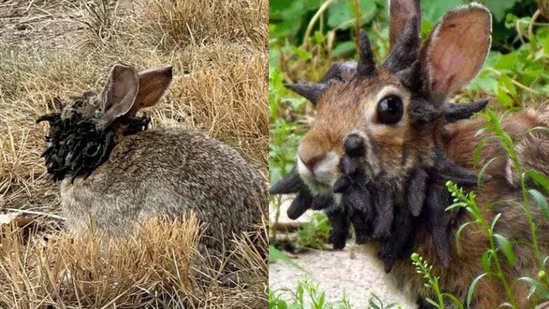What’s cottontail rabbit papillomavirus (CRPV)? Understanding the infection behind Colorado’s mysterious “horned” rabbits

Wild rabbit in Colorado with Shope papilloma virus growths on its head
Cottontail rabbit papillomavirus, or CRPV, is a viral infection that affects wild rabbits, most commonly cottontail species. The virus is responsible for the unusual “horn-like” growths observed on the faces of some rabbits in Colorado and other areas. Although the appearance of these growths may alarm observers, CRPV is a natural virus that is species-specific, meaning it only infects rabbits and poses no direct threat to humans or other animals.
How CRPV Spreads
CRPV is primarily transmitted through direct contact between rabbits or indirectly via insect bites. Fleas, ticks, and other biting insects can carry the virus from one rabbit to another. Infections tend to occur more frequently during the warmer months of the year when insect activity is highest, explaining why “horned” rabbits are most commonly seen in summer.
READ ALSO
What to know about Colorado’s mysterious “horned” rabbits — are they harmful to residents?
Symptoms and Appearance
The hallmark of CRPV infection is the development of dark nodules on a rabbit’s head, around the mouth, and sometimes on the ears. These nodules can elongate, forming spike-like or horn-like protrusions, which give infected rabbits their unusual and sometimes frightening appearance. While these growths are visible and can look severe, they generally do not cause serious health problems unless they interfere with the rabbit’s ability to eat or drink.
Impact on Wild and Domestic Rabbits
In wild cottontail rabbits, CRPV infections are usually self-limiting. Most rabbits recover naturally as the growths gradually regress, and the virus does not typically harm the animal’s overall health. Pet rabbits, however, can experience more severe infections, so veterinary care may be necessary if a domestic rabbit becomes infected. Keeping pet rabbits away from wild populations helps reduce the risk of transmission.
Human and Other Animal Risk
CRPV is strictly a rabbit-specific virus. Humans and other animals cannot contract the infection, making it a concern mainly for rabbits themselves. Nevertheless, it is recommended to avoid handling infected rabbits, both to prevent stress on the animal and to minimize the potential spread to other wild or domestic rabbits.
Management and Prevention
There is no need for alarm regarding CRPV in wild rabbits. For pet owners, monitoring their rabbits and maintaining clean living environments can reduce the risk of infection. In the wild, giving infected rabbits space and avoiding direct contact helps prevent the virus from spreading through local rabbit populations.
Bottom Line
Cottontail rabbit papillomavirus is the biological explanation behind the so-called “horned” rabbits seen in some parts of the United States. While the growths may appear bizarre, the virus is generally harmless to wild rabbits and poses no risk to humans. Awareness, careful observation, and minimal interference are key to managing and understanding this fascinating wildlife phenomenon.

